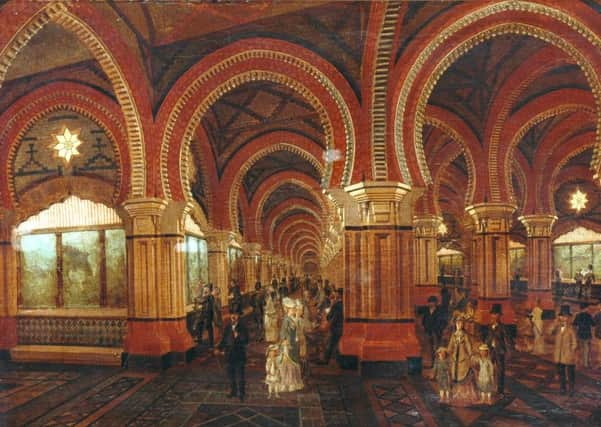Scarborough's underground world of wonder and curiosity


May 1853 saw the opening of the ‘Marine Vivarium’ at the London Zoological Gardens in Regent’s Park. This was arguably the first public aquarium and allowed people to see marine wonders for the first time. The public were hungry for such amusements and the aquarium proved hugely popular and also hugely profitable. Over the next few decades, aquariums sprang up all over the world and could be found in Dublin, New York, Boston, Paris, Brussels, Berlin and Boulogne amongst other places.
In 1869 major redevelopments were occurring in Brighton and as part of the improvements the famed seaside architect and wonderfully named Eugenius Birch was approached to build an aquarium. Eugenius Birch is now mainly remembered for his pier building, but as we shall discover, he was much more than a one trick pony. Having visited the aquarium in Boulogne and taking inspiration from it, Birch had planned for the Brighton Aquarium to be a substantial building with majestic towers, but it was deemed this would spoil the sea view from the promenade. To get round this problem, Birch took the bold step of proposing a subterranean pleasure palace which would allow huge marine tanks (at the time, the largest in the world) as well as room for dining and decorative features such as cascades and an elegant fernery.
Advertisement
Hide AdAdvertisement
Hide AdThe Brighton project was completed in 1872 at a cost of £130,000 and was inaugurated by Prince Albert at Easter, although at this point there were no displays. It was formally opened by the mayor, Mr Cordy Burrows, on August 10, and was celebrated around the world.
Eugenius Birch was familiar with Scarborough having built the north bay pier which opened to much praise in 1869, and following the completion of the Brighton Aquarium he became the chief engineer of the Scarborough and Whitby Railway, on which work began in 1872, although it wouldn’t open until 1885. Seeing the success of the Brighton Aquarium a consortium of local and national businessmen formed the Scarborough Aquarium Company and shares were sold to raise capital.
Working to a design by Mr Birch, and under his personal superintendence, Messrs. Kirk and Parry of Sleaford commenced work in the summer of 1874. Kirk and Parry were also constructing the Scarborough and Whitby Railway, so were clearly experienced in such major civil engineering as this ambitious project. A description of the proposed work from the Manchester Courier dated 16th June 1874 gives an indication of the extent of the proposal:
“The site of the Aquarium is the Old Horse and Carriage Stand, so well known to all visitors of Scarbro’, and the intention is to excavate the whole of this space and the adjoining roads, which will give a site of wide area. Over the buildings a wide carriage-road will be formed, giving a handsome approach to the sands, which will be continued by a good roadway for some extent along the foreshore.”
Advertisement
Hide AdAdvertisement
Hide AdAs at Brighton, the underground structure allowed the construction of substantial buildings without compromising the sea views. There were very few hitches considering the scale of the job which not only involved the removal of huge amounts of rock and earth, water pipes and drains had to be diverted, and the Mill Beck had to be culverted and piped below the beach. The most dramatic event during the construction occurred in November 1875. One Saturday morning between five and six am a wall collapsed over an area of around 20 yards and many hundreds of tons of earth were displaced. The culprit was a fractured water pipe which had been leaking since the Friday night. Due to the early hour of the occurrence, no one was injured, but much of Scarborough was without water for most of the day. In February the following year an arch in the main corridor collapsed beneath a foreman named Mr Smith. Despite falling 20 feet and suffering some serious injuries, he survived. For such a major construction work to be completed without loss of life was impressive in Victorian times.
During the construction of the aquarium it was noted in the reports of the Scarborough Philosophical Society that the disruption had caused a reduction in the number of visitors to the Rotunda Museum, but they admitted that on completion the improved roadways and additional visitors to the area would undoubtedly increase the number of visits to the museum, which indeed proved correct.
Considering the project had taken three years to complete, the grand opening on the May 19, 1877, passed with little ceremony, and at two o’clock the turnstiles opened, and ex-mayor John Hart was the first to pay his shilling and pass in. During the afternoon over 1,000 people were admitted, and nearly twice as many assembled in the evening and were entertained by the Band of the Yorkshire Regiment of Artillery Militia. One of the displays that seems to have proved very popular was a tank allowing people to watch puffins and guillemots chasing fish.
The aquarium, though popular at first was never the success it should have been, and following a number of changes of use, it closed in 1966 and the site was demolished in 1968. During its existence it wasn’t without incident, from rogue elephants to trams crashing through the ceiling, and some readers may have fond memories of its final days as Gala Land.
Advertisement
Hide AdAdvertisement
Hide AdThere is much that can be said about the history of the Aquarium and Gala Land, and it may well be a subject we revisit in the future.
The painting of the Aquarium is part of the Scarborough Collections, the name given to all the museum objects and artwork acquired by the borough over the years, and now in the care of Scarborough Museums Trust. For further information, please contact Collections Manager (maternity cover) Simon Hedges on [email protected] or 01723 384505.